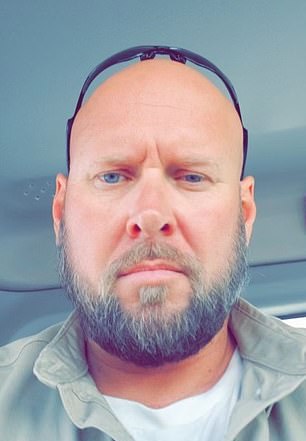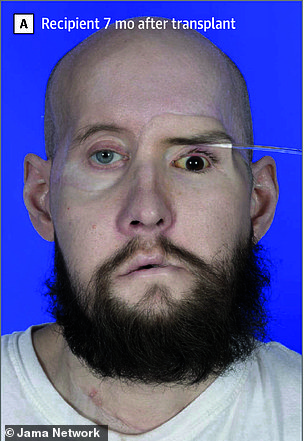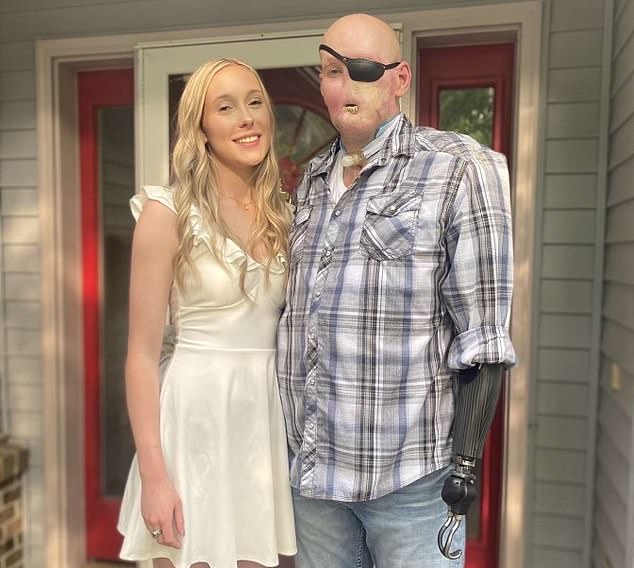Arkansas man who received world’s first eye and face transplant describes ’emotional’ moment he kissed wife and ate pizza for first time since horrific electrical accident
When Aaron James, 47, accidentally touched a live wire while working as a mechanic, doctors weren’t sure if he would make it out alive.
The Arkansas war veteran lost large portions of the left half of his face, his arm and his eye and could no longer smell, taste or move his mouth.
But last year, in a world-first operation that took 140 doctors at NYU Langone 21 hours to complete, Mr. James received a new eyeball and a new face from an anonymous donor.
The surgery allowed his wife of more than 20 years, Meagan James, 39, to kiss again. Mrs. James said their first kiss after the transplant was emotional, and: “Just to have that back was really special.”
Mr. James (pictured with his wife Meagan) spent just 17 days in intensive care. The two were able to kiss for the first time since the transplant


Before his accident, Mr. James worked as an electrician and served multiple tours in the Middle East with the U.S. Army. Mr. James was released from the hospital in July, just months after his transplant surgery in May
Since the surgery took place in New York in May 2023, doctors have been closely monitoring the Arkansas war veteran for signs that the experimental operation has failed.
He has exceeded all expectations, recovering in record time in intensive care and far exceeding the expectations of his transplant team.
Now he enjoys doing ‘normal things’ again, like eating solid food.
Because his injuries were so severe, the father of one had been eating only liquid food for two years.
“I knew I would be back to normal (on track) if I could eat pizza,” Mr. James said. And now, thanks to the experimental surgery, he can.
Dr. Eduardo D Rodriguezthe chief surgeon and director of the Face Transplant Program at NYU Langone, said: “Many experts thought we would never get here, but we have successfully transplanted and preserved an eye without immune system rejection.’
Dr. Rodriguez led the team of more than 100 surgeons, nurses and support staff as they removed the muscle, nerves, fat and skin, as well as the left eye, from an anonymous organ donor.
They then began a race against time, trying to attach every millimetre-wide nerve that controls the eye to Mr James’ face before the organ died. They also flushed the area around the optic nerves with donor stem cells, hoping this would help the nerves grow.
Dr. Elizabeth A. Bradley A Mayo Clinic ophthalmologist who was not involved in the transplant said, “The procedure was both an engineering and technological feat.”
According to Dr. Bradley, doctors have been devising different ways to perform eye transplants since the 1970s, in part because many forms of blindness, which affect more than 1 million Americans, have no treatment.
But it seemed nearly impossible to transport because as soon as it was cut from the donor, the nerves in the eye began to die because the eye was no longer getting blood, Dr. Bradley said.
Once an eye is implanted, the body can reject the new organ, reacting as if it were a virus or infection, making the recipient sick.
Mr. James, who had served society through the army and as an electrician, was prepared to take the risks.
“That’s really my biggest hope out of this deal. I mean, if I can see through it (my eye), that’s great. But if it’s going to be the next step in the medical field, then I’m all for it,” Mr. James told CNN.
The following year the organ The size and blood flow were preserved and the rest of the transplanted facial skin remained healthy.
At this point, Mr. James cannot see out of the donor eye, although his right eye still functions fine. But blood flow and some additional testing give doctors hope that there is still a chance he will be able to see in the future.

Mr. James returned home to Arkansas with his wife and daughter (pictured) in September 2023.
For example, brain scans show activity in the part of the brain responsible for vision in the left eye, said Dr. Jeffery Goldberg, an ophthalmologist at Stanford who was not involved in the study.
He added: ‘MRI data are not convincing enough to suggest regenerative growth, but they are a promising finding that supports that hope.’
As the patient continues to take a complex cocktail of medications to control infection, he will receive regular visits from doctors to monitor the progress of his eye.
“The next challenge is to understand how to restore vision. I look forward to continuing this research in collaboration with academia to accelerate these discoveries with unique tools and best-in-class therapies,” said Dr. Rodriguez.
The fact that he can no longer see out of his eyes at the moment has not diminished Mr James’ gratitude. He said he felt ‘honoured to be patient zero’.
“I have been given a second chance and I don’t take any moment for granted.”
